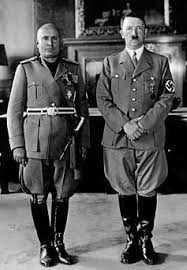Yelling ‘Fascist!” is one vivid and quite effective way to shut down an honest debate – in the pre-mask era, a bit of spittle also helps. It’s a variation of Aristotle’s ad baculum fallacy, literally, ‘to the stick’, to beat someone into submission, either literally or figuratively. Few who tout it seem able to define it, and I have some doubt many of us could historically locate its origin. So I’m heartened that Stanely Payne wrote these words on this blithe epithet in First Things – as he frames it, we have anti-fascism without any real fascism to be against. Or, more to the point, we have the ‘anti-fascists’ – who act like real fascists – claiming to fight fascists, a product of their own fantasy, who are not fascists at all, if you get my gist.
If anything, our current woke generation would stick the term to the Nazis – the other day marked the anniversary of Hitler’s accession to the Chancellorship of Germany in 1933, when he was a relatively unknown failed artist and an embittered First World War veteran, but, as Cindi Lauper would later sing, he let his true colours shine through – red, white and a black.
But, it was actually Mussolini who began the ‘Fascist’ movement, with his dreams of recapturing the military might of ancient Rome in a resurgent Italy. Hitler followed suit in striving to capture the military glory of ancient Germany and Frederick Barbarossa. And while we’re at it, we can include Josef Stalin who, as an atheistic Communist, also adopted the modus operandi of ‘Fascism’ as a resurgence of Slavic might and empire. These three amoral amigos all had their day, and all met bitter and tragic ends – Hitler, gone mad, by suicide in his underground bunker; Mussolini shot while trying to flee, and hung upside down from a lamppost with his mistress; and Stalin dying in his own froth after a ‘stroke’, which may have been the effect of poison of which he had been so paranoid.
So, what is ‘Fascism’, and did they both deserve the label, or libel? Well, it’s difficult to define – forget the puffy pants and the Hugo Boss leather boots and suits, which are mostly accidental – but I thought it might be described with the following somewhat arbitrary ten characteristics. These may be slightly modified, and I am, as always, open to critique:
- Such regimes often seize full power by taking advantage of a crisis, coup (fake or not) or calamity – never let a good one go to waste! – or even permitting and/or fomenting such: The burning of the Reichstag in 1933, conveniently four weeks after Hitler was elected, blamed on the Communists. Mussolini had his Italian revolutionaries who could not make the trains run on time and whose policies produced economic chaos; and Stalin, well, he had his semi-imaginary capitalistic ‘bourgeoise’ oppressing the proletariat. This allows the up-and-coming regime to ‘blame’ the other side for whatever was wrong, and justify their own, all-too-real, military take-over.
- The use of semi-controlled mobs both increase the chaos, but also impose their own kind of order – the Brownshirts of the Nazis, the Blackshirts of Mussolini, the Bolsheviks of Stalin – with plausible deniability of any, ahem, ‘excesses’, to official connection to the regime.
- The consolidation of absolute power in the State, for the ‘good of the people’ and to restore peace, tranquility and unity: everything from the definition of marriage and family, to education, health care, and even large swathes of private property are thus collectivized.
- Hence, a socialist mentality predominates – the State, that is the ‘Party’ always, always knows best.
- A dependence on the police, military and other quasi-secret government agencies to enforce absolute control and coercive decrees.
- An obsession of the leader(s) with his/her/their personal safety, and the surrounding of the same person(s), and their capital, with multiple layers of armed protection.
- A take-over of the media, with persistent propaganda, offering only one ‘narrative’ – that of the ‘Party’, repeated until accepted. As one author put it, great is the power of steady misrepresentation. Quite effective in our own day and age.
- A re-writing of history, with an emphasis on the present tense, the opinions and perspective of current generation always presented as more enlightened than all the rest – indeed, as absolute and obvious truth, and soon the only point of view permitted.
- The crushing of dissent or any other narrative – especially of the Christian sort – at first by ‘passive’ means, the blocking of any means of communication by any dissenters. Then, when that runs out, more iron-fisted methods, with jail time and then some.
- And, back to where we began, the ‘demonizing’ of any dissenters, as disloyal, or other epithets that stick (say, ‘fascist’, or ‘racist’, or ‘white supremacist’ or…Well, you get the gist).
Rather than ‘fascist’, we might prefer the term Pope Saint John Paul II and our Church’s tradition uses: totalitarianism, the denial of the transcendent, and the subjugation of all things to one earthly ruling power, a ‘secular and pseudo messianism’, promising salvation in this world and this age alone.
We will leave the reader to decide who the real fascists – or totalitarians – are.
But fret not, dear reader. They may have their day, but as the Psalm says, God laughs them to scorn.











